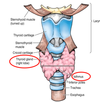Thyroid & Parathyroid glands Flashcards
What are the three layers of the cervical viscera, superficial to deep?
- Endocrine layer: the thyroid and parathyroid glands.
- Respiratory layer: the larynx and trachea.
- Alimentary layer: the pharynx and esophagus

What 2 hormones are produced by the thyroid + what are their functions?
thyroid hormone (T3,T4), which controls the rate of metabolism
calcitonin, a hormone decreasing calcium metabolism.
What hormone is produced by the parathyroid glands + what is its function?
parathormone (PTH), controls the metabolism of phosphorus and calcium in the blood; increases calcium level in blood.
The parathyroid glands targets what 3 regions/structures in the body?
skeleton
kidneys
bones

The thyroid gland lies deep to which 2 muscles located anteriorly in the neck?
It lies at the level of which vertebrae?
- sternothyroid + sternohyoid muscles
- C5 - T1
The right and left lobes of the thyroid lie where, in relation to the larynx and trachea?
What connects the 2 lobes and at what level?
- anterolateral to the larynx + trachea
- thin isthmus; usually anterior to the 2nd + 3rd tracheal rings.

Dense connective tissue attaches the fibrous thyroid capsule to which 2 structures?
•External to the capsule is a loose sheath formed by …?
- the cricoid cartilage and **superior tracheal rings. **
- the visceral portion of the pretracheal fascia (deep cervical fascia)
Which 2 arteries lie between the fibrous capsule + the loose fascial sheath supplying blood to the thyroid?
- superior + inferior thyroid arteries
*1st branch of ECA = superior thyroid artery: descends to superior poles of gland, pierce pretracheal fascia, +divides into anterior + posterior branches supplying mainly the antero-superior aspect of the gland
** accompanied by External Laryngeal Nerve –> innervates cricothyroid m.

•The inferior thyroid arteries are the largest branches of what?
- thyrocervical trunks (fr. subclavian arteries)
- * run superomedially posterior to the carotid sheaths to reach the posterior aspect of the thyroid gland. *
- **divide into several branches that pierce the pretracheal layer of the deep cervical fascia + supply the posteroinferior aspect, including the inferior poles of the gland. *
- *** right + left superior / inferior thyroid arteries anastomose extensively within the gland*
Thyroid Ima Artery
- found in what percentage of people?
- usually arises from what artery?
- location?
- supplies blood to…?
- 10% of people
- brachiocephalic trunk
- (may arise fr. arch of the aorta or from the right common carotid, subclavian, or internal thoracic arteries)*
- -* ascends on the anterior surface of the trachea
- divides and supplies the isthmus
*artery must be considered when performing procedures in the midline of the neck inferior to the isthmus (tracheotomy) because it is a potential source of bleeding

What are the three pairs of thyroid veins (usually forming a thyroid plexus of vv.) on the anterior surface of the thyroid gland (anterior to the trachea)?
- superior thyroid veins: accompany superior thyroid arteries; drain the superior poles of the thyroid gland; drains into IJV
- middle thyroid veins: do not accompany but run essentially parallel courses with the inferior thyroid arteries; they drain the middle of the lobes; drains into** IJV**
- Inferior thyroid veins: usually independent; drain the inferior poles; drains into **brachiocephalic v. **(posterior to the manubrium)
THYROID ARTERIES

THYROID VEINS

Lymphatic vessels from thyroid gland run where?
The vessels pass into the prelaryngeal, pretracheal, + paratracheal nodes, whic hdrain into..?
- in the interlobular connective tissue
- *(they communicate with a capsular network of lymphatic vessels)*
- superior deep cervical nodes (from the prelaryngeal nodes) + inferior deep cervical nodes (from the pretracheal and paratracheal nodes).
- **Laterally, vessels along superior thyroid veins pass directly to inferior deep cervical lymph nodes; some nodes may drain into the brachiocephalic lymph nodes or thoracic duct.*

thyroid cancer
- most common type of endocrine cancer
- Low iodine, high radiation all contribute to increased incidence
- Prognosis serious b/c lymph nodes located in close proximity to carotid sheath.. difficult to remove without injuring these vessel; life expectancy usually 1-2 years MAX.
- May also metastasize to the lungs

- Nerves of the thyroid gland are derived from the …(3) ganglion?
- They reach the gland through which 3 plexuses?
- Are the fibers vasomotor or secretomotor?
- Endocrine secretion from the thyroid gland is hormonally regulated by the ..?
- superior, middle, + inferior cervical sympathetic ganglia.
- cardiac + superior & inferior thyroid periarterial plexuses (accompany thyroid aa.)
- vasomotor (cause constriction of blood vessels)
- pituitary gland!!!




